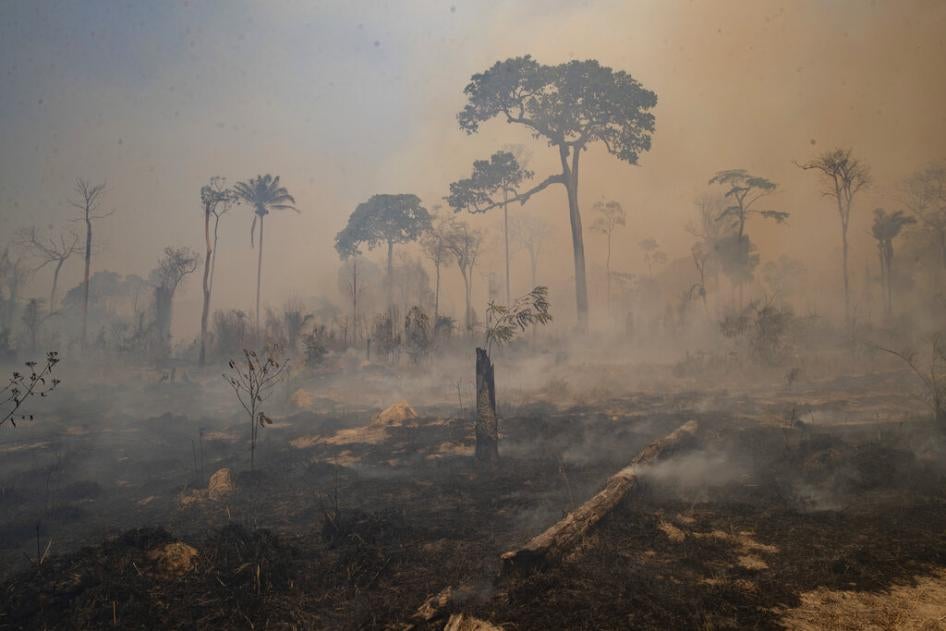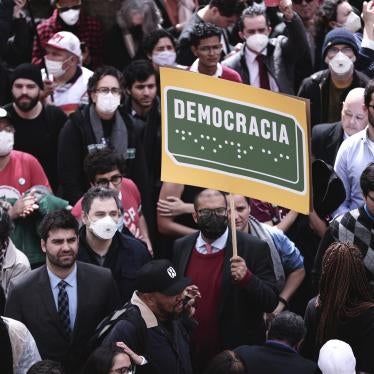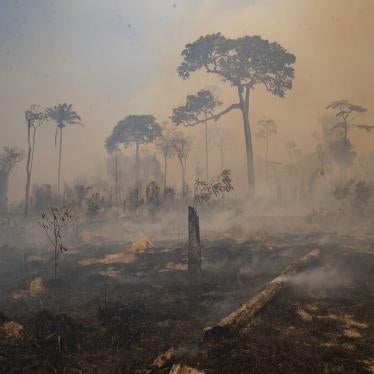The violence associated with environmental destruction in the Amazon was briefly in the spotlight this year when news of the killing of the Indigenous rights advocate Bruno Pereira and the journalist Dom Philips spread through the world. But candidates to the October 2 elections ignored the pressing human rights issues of how to protect forest defenders or tackle the root causes of such violence. Candidates running for president and governors in the October 30 runoff should tell voters how they intend to address those challenges if elected.
In recent years, the government has scaled back environmental law enforcement, and the sharp increase of illegal deforestation, mining, and land-grabbing have revealed the strength of criminal networks that intimidate, threaten, and attack those who stand in their way. The non-profit Pastoral Land Commission (CPT, in Portuguese) estimates that since January 2020 more than 60 people have been killed in conflicts over natural resources and land in the Brazilian Amazon.
These alarming numbers should have prompted Brazil to roll out a comprehensive plan to protect forest defenders that involves all levels of government. Instead, there is a hodgepodge of uncoordinated and insufficient efforts. In May 2021 a court ordered the government to develop a national plan to protect human rights defenders, but that hasn’t happened. Brazil needs stronger agencies working together to enforce environmental laws, fight land-grabbing, and prosecute those who destroy the forest and attack defenders, including criminal groups operating in the Amazon.
Brazil has had a federal human rights protection program since 2004. As of July, it served 87 people, with another 55 cases pending. The program provides some protection, such as regular phone contact, police patrols, and escorts. But many defenders say that the protection is grossly insufficient.
And many defenders find it hard to trust the program, housed in the Ministry of Family, Women, and Human Rights, while the federal government is taking measures that facilitate environmental destruction and effectively empower criminal groups in the Amazon. The number of people who applied for the program fell from 63 in 2018 to 28 in 2021, according to official data.
Some states have their own programs. In those areas, the federal program partially finances protection efforts. About 400 people had state-level protection in 2021, while another 90 requests were pending, the latest data available.
The director of protection and defense of human rights at the Ministry, who oversees the federal program, told Human Rights Watch that state programs are better placed to protect defenders because they have a better understanding of the situation on the ground and can more easily mobilize state law enforcement officials to provide protection.
But only three of the nine states in the Amazon—where most of Brazil’s conflicts over lands and resources take place—have their own programs. Amazonas state, for example—where Pereira and Philips were murdered—signed an agreement with the federal program four years ago to establish its program and has federal funding available. Yet, the director of the federal program said in June that the Amazonas program had not yet started providing any protection.
Neighboring Pará state has an operating program, but some defenders told me it provides little meaningful protection—sometimes no more than periodic check-ins. One said he had to pay for the gasoline for the police car assigned to protect him. And defenders sometimes fear or distrust the police officers, fearing they could be involved with the criminal groups that threaten them.
Both federal and state programs are supposed to be able to mobilize police, prosecutors, environmental agencies, and other state and federal government bodies to support defenders, but those agencies don’t always respond. An additional challenge is making quick arrangements to ensure defenders have prompt access to health care, psychological support, and other services that are very important for them to continue their work as defenders.
Brazil should also offer collective protection measures to communities at risk, such as Indigenous peoples and other rural communities threatened by people involved in illegal mining, logging, and land-grabbing. Colombia has been exploring these types of approaches for years, among other things, by providing vehicles and cellphones to Indigenous defenders who protect their territory and the environment.
Many Amazon defenders told us they would favor those collective measures, which they think could lessen the targeting of outspoken leaders while enhancing security for families, associations, and entire communities.
The government also needs to improve coordination among its agencies. Keeping defenders safe should not be viewed as the exclusive job of state and federal protection programs. They need the support of the rest of the government.
Candidates elected at the federal and state levels should commit to strengthening Brazil’s protection programs, including by allocating appropriate resources. The federal and state programs need to train public officials, adopt clear methodologies and criteria to assess risks, and guarantee that information about forest defenders is kept confidential. They should also listen to local organizations and defenders about how to improve protection.
Long-term protection also requires a national system to resolve the underlying conflicts that give rise to threats, attacks, and killings.
Brazil’s elected officials should design and implement policies to tackle the Amazon’s environmental crisis and protect forest defenders.
* A shorter version of this article was published in Folha de São Paulo










